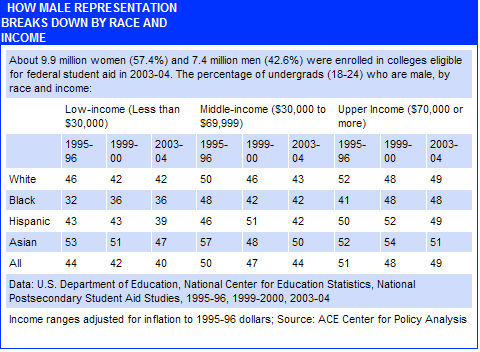
Cal Poly is an unusual university. In Fall 2005, we enrolled 56.5% men and 43.5% women, according to the official Cal Poly Fact Book. Although we have no formal research as to why this occurs, most people assume the campus emphasis on Engineering has something to do with it.
In contrast, the official student profile report published by the California Postsecondary Education Commission reports that enrollment by women in the CSU, of which Cal Poly is a part, grew from 53.2% to 57% between 1993 and 2003. In the University of California system, enrollment by women grew from 50.6% to 53.5% over the same period.
The question being asked is “why aren’t men going to college?” A related question is, “Should we worry about their not choosing to do so?”
Back in 1974, Maccoby and Jacklin [1] concluded that females had a slight edge in verbal tasks, whereas males had a slight edge in visuospatial tasks, a finding that has held up quite robustly over the past 30 years. Judith Kleinfeld at the University of Alaska, Fairbanks, recently reported that boys at all socioeconomic levels trailed girls in language arts. According to Kleinfeld’s data, one quarter of the sons of college-educated, white-collar workers fell into the lowest “below basic” quartile of reading and writing skills, while only 6-7% of the daughters in this group scored at this level.
So theory one is that we need to shore up male language skills to make them more competitive for college entrance.
On the other hand, data from ACE suggest that male college enrollment is closely related to family income:
Particularly notable are the drops in college enrollment the last decade among lower and middle income males.
With the availability of fewer blue-collar jobs, where could these men be going? One option that has not, to my knowledge, entered the public discussion among academics is that many are going into the military.
When the United States abandoned the draft for an all-volunteer military in 1973, the combined military services became the largest employer in the United States [2]. Although the number of Americans in uniform dropped from 2 million in 1973 to 1.4 million in 2004, this is still a lot of people. These figures do NOT reflect those serving in national guard or reserve units either.
Who are these soldiers [2]? They are less likely to have college-educated parents. Although one of the benefits of enlistment is large amounts of money for later college costs, enlistees are less likely to have high grades in high school or plans to attend college. Women make up about 15% of this new military, but are restricted to certain branches and job descriptions.
So here is a new theory–maybe men, particularly those without family financial support for college, are opting for the military instead.
In addition to the obvious draws of service to the nation and financial incentives, maybe today’s males are drawn to the outright macho nature of the military. John Travolta, observing training by Army Rangers, is said to have been amazed by what he saw–the “most macho” activity on the planet. The military understands this appeal. After showing pictures of guys doing macho things, one Navy recruiting commercial features the tag line: “and to think, somewhere, someone is buying a minivan.”
College can be very non-macho. Many of my male students have complained of perceived male-bashing in the classroom. One agitated student said that he would quit the next time a professor told the men in the room that they were responsible for the gender gap in pay.
Let’s return to the statistics. According to the table above, 17.3 million people were in college in the 2003-2004 academic year. If you added the 1.2 million men in the military to the 7.4 million men in college, you would get 8.6 million, which would move men up to 46.5% of the people in college.
Now this isn’t fair. Most officers have college degrees already, and enlisted personnel are more likely to have attended college today. Not all enlistees want to go to college. But even if some percentage of these men are simply delaying college to serve in the military, the gender gap in college makes a lot more sense.
- Maccoby, E.E, & Jacklin, C.N, (1974). The Psychology of Sex Differences. Stanford: Stanford University Press.
- Segal, D.R., & Segal, M.W. (2004). America’s Military Population. Population Bulletin, 59(4). Retrieved on July 17, 2006 from http://www.prb.org/Template.cfm?Section=Population_Bulletin1&template=/ContentManagement/ContentDisplay.
cfm&ContentID=12460.



1 Comment
Roger’s View of the World, Love and Seafood Gumbo! » Where Have all the Men Gone? · September 15, 2006 at 11:14 am
[…] My Laura wrote an interesting blog along this line entitled ” where the boys are” that discusses the changing priorities and opportunities facing men. […]
Comments are closed.